Experimental Study on Flexural Performance of Screw Clamping and Welding Joint for Prestressed Concrete Square Piles
Abstract
1. Introduction
2. Test Setup
2.1. Specimen Design
2.2. Test Apparatus
3. Analysis of Bending Test Results
3.1. Evaluation of Flexural Capacity
3.2. Load-Mid-Span Deflection Curve
3.3. Test Failure Pattern
3.4. Specimen Crack Development
3.5. Weld Strain Development
4. Summary
5. Limitations and Prospects
Author Contributions
Funding
Data Availability Statement
Conflicts of Interest
References
- Gao, W.S.; Liu, J.L.; Zhao, X.G.; Qiu, M.B. Some understanding of prestressed concrete pipe pile in engineering application. Rock Soil Mech. 2015, 36, 610–616. [Google Scholar]
- Ren, J.; Xu, Q.; Chen, G.; Liu, C.; Gong, S.; Lu, Y. Flexural performance of pretensioned centrifugal spun concrete piles with combined steel strands and reinforcing bars. Structures 2021, 34, 4467–4485. [Google Scholar] [CrossRef]
- Ren, J.; Xu, Q.; Chen, G.; Yu, X.; Gong, S.; Lu, Y. Full-scale experimental study of the seismic performance of pretensioned spun high-strength concrete piles. Soil Dyn. Earthq. Eng. 2022, 162, 107467. [Google Scholar] [CrossRef]
- Dolati, S.S.K.; Mehrabi, A. Review of available systems and materials for splicing prestressed-precast concrete piles. Structures 2021, 30, 850–865. [Google Scholar] [CrossRef]
- CABR (China Academy of Building Research). JGJ/T 406-2017; Technical Standard for Prestressed Concrete Pipe Pile. China Architecture & Building Press: Beijing, China, 2017.
- Li, Z.Y.; Ke, Z.B.; Liu, D.J.; Lu, Z.T.; Guo, Y. Tests on PHC pipe pile joint quality by low-strain reflected wave method. Chin. J. Geotech. Eng. 2011, 33 (Suppl. S2), 209–212. [Google Scholar]
- Chen, C.; Yang, L.D. Experimental research on concrete permeability of underground structure. Rock Soil Mech. 2011, 32, 2379–2385. [Google Scholar]
- Huang, F.M.; Cao, Z.S.; Jiang, S.H.; Zou, G.B.; Guo, Z. Landslide susceptibility prediction based on a semi-supervised multiplelayer perceptron model. Landslides 2020, 17, 2919–2930. [Google Scholar] [CrossRef]
- Huang, F.M.; Cao, Z.S.; Guo, J.F.; Jiang, S.H.; Guo, Z. Comparisons of heuristic, general statistical and machine learning models for landslide susceptibility prediction and mapping. CATENA 2020, 191, 104580. [Google Scholar] [CrossRef]
- Chang, Z.; Du, Z.; Zhang, F.; Huang, F.; Chen, J.; Li, W.; Guo, Z. Landslide susceptibility prediction based on remote sensing images and GIS: Comparisons of supervised and unsupervised machine learning models. Remote Sens. 2020, 12, 502. [Google Scholar] [CrossRef]
- Furong, L.; Liao JI, A.; Cheng, L.I. The Test Study on Welding Joint Flexural Bearing Capacity of Prestressed Concrete Hollow Square Pile. J. Wuhan Univ. Technol. 2008, 5, 105–108. [Google Scholar]
- Weixing, L.; Yuerong, W.; Qingbin, L. Design and experimental study on a new connection between PHC uplift pile segments of the Expo Theme Pavilion. J. Build. Struct. 2010, 5, 83–94. [Google Scholar]
- Xu, Q.B.; Chen, G.; He, J.F.; Gong, S.F. Flexural performance experiment of composite reinforcement concrete prefabricated square piles. J. Zhejiang Univ. Eng. Sci. 2016, 50, 1768–1776. [Google Scholar]
- Xu, Q.B.; Chen, G.; He, J.F.; Gong, S.F.; Xiao, Z.B. Flexural performance experiment of connection joint for composite reinforcement concrete prefabricated square piles. J. Zhejiang Univ. Eng. Sci. 2017, 51, 1300–1308. [Google Scholar]
- Xu, Q.B.; Yang, F.; Chen, G.; Gong, S.F.; Xiao, Z.B. Finite element analysis of flexural performance of composite reinforced concrete prefabricated square piles. J. Build. Struct. 2018, 39, 297–305. [Google Scholar]
- Guo, Y.; Cui, W.; Chen, F.; Chen, Q. Analysis and experimental study of a PHC uplift pile with hold-hoop connection. Chin. J. Geotech. Eng. 2013, 35, 1007–1010. [Google Scholar]
- Wu, Z. Effective Post-Tensioned Splicing System for Prestressed Concrete Piles. Master’s Thesis, University of South Florida, Tampa, FL, USA, 2016. [Google Scholar]
- Lu, L.; Han, S.; Chen, Z.; Wang, G.; Wang, Y.; Zhao, K. Study on bending performance of prefabricated square pile with socket and spigot joint. J. Build. Struct. 2018, 39, 153–161. [Google Scholar]
- Wang, Y.F.; Chen, G.; Xu, Q.B.; Gong, S.F.; Xiao, Z.B.; Fan, H. Study on tensile behavior of prestressed concrete square pile connection joint with resilient clamping. J. Disaster Prev. Mitig. Eng. 2018, 38, 1003–1011. [Google Scholar]
- Yang, Z.; Li, G.; Wang, W.; Lv, Y. Study on the flexural performance of prestressed high strength concrete pile. KSCE J. Civ. Eng. 2018, 22, 4073–4082. [Google Scholar] [CrossRef]
- Yang, Z.; Li, G.; Wang, W. Experimental investigation and nonlinear finite element analysis on seismic performance of PHC piles. Struct. Eng. Int. 2018, 28, 475–488. [Google Scholar] [CrossRef]
- Zhang, X.; Gong, S.; Xu, Q.; Gan, G.; Yu, X.; Lu, Y. Flexural performance of pretensioned spun concrete piles reinforced with steel strands. Mag. Concr. Res. 2022, 74, 757–777. [Google Scholar] [CrossRef]
- Tang, M.; Ling, Z.; Qi, Y. Bending strength of connection joints of prestressed reinforced concrete pipe piles. Buildings 2023, 13, 119. [Google Scholar] [CrossRef]
- GB/T 5223.3-2005; Steel Rods for Prestressed Concretes. China Standards Press: Beijing, China, 2010.
- GB 13476-2023; Prestressed Spun Concrete Square Piles. China Standards Press: Beijing, China, 2023.
- GB 50152-2012; Standard for Test Methods of Concrete Structures. China Architecture & Building Press: Beijing, China, 2012.
- GB 50010-2010; Code for Design of Concrete Structures. China Architecture & Building Press: Beijing, China, 2015.
- GB/T 5117-2012; Covered Electrodes for Manual Metal Arc Welding of Non-Alloy and Fine Grain Steels. China Standards Press: Beijing, China, 2012.
- Ren, J.; Xu, Q.; Chen, G.; Yu, X.; Gong, S.; Lu, Y. Seismic Performance of Pretensioned Centrifugal Spun Concrete Piles with Combined Steel Strands and Deformed Steel Bars. J. Struct. Eng. 2023, 149, 04023147. [Google Scholar] [CrossRef]
- Ren, J.; Xu, Q.; Chen, G.; Yu, X.; Gong, S.; Lu, Y. Seismic performance of pretensioned centrifugal spun concrete piles with steel strands. Structures 2023, 50, 1303–1319. [Google Scholar] [CrossRef]
- Zhang, X.; Zhang, S.; Xu, S.; Niu, S. Study of seismic behavior of PHC piles with partial normal-strength deformed bars. Earthq. Eng. Eng. Vib. 2020, 19, 307–320. [Google Scholar]
- Wang, P.; Huang, J.; Tao, Y.; Shi, Q.; Rong, C. Seismic performance of reinforced concrete columns with an assembled UHPC stay-in-place formwork. Eng. Struct. 2022, 272, 115003. [Google Scholar] [CrossRef]
- Tong, T.; Zhuo, W.; Jiang, X.; Lei, H.; Liu, Z. Research on seismic resilience of prestressed precast segmental bridge piers reinforced with high-strength bars through experimental testing and numerical modelling. Eng. Struct. 2019, 197, 109335. [Google Scholar] [CrossRef]
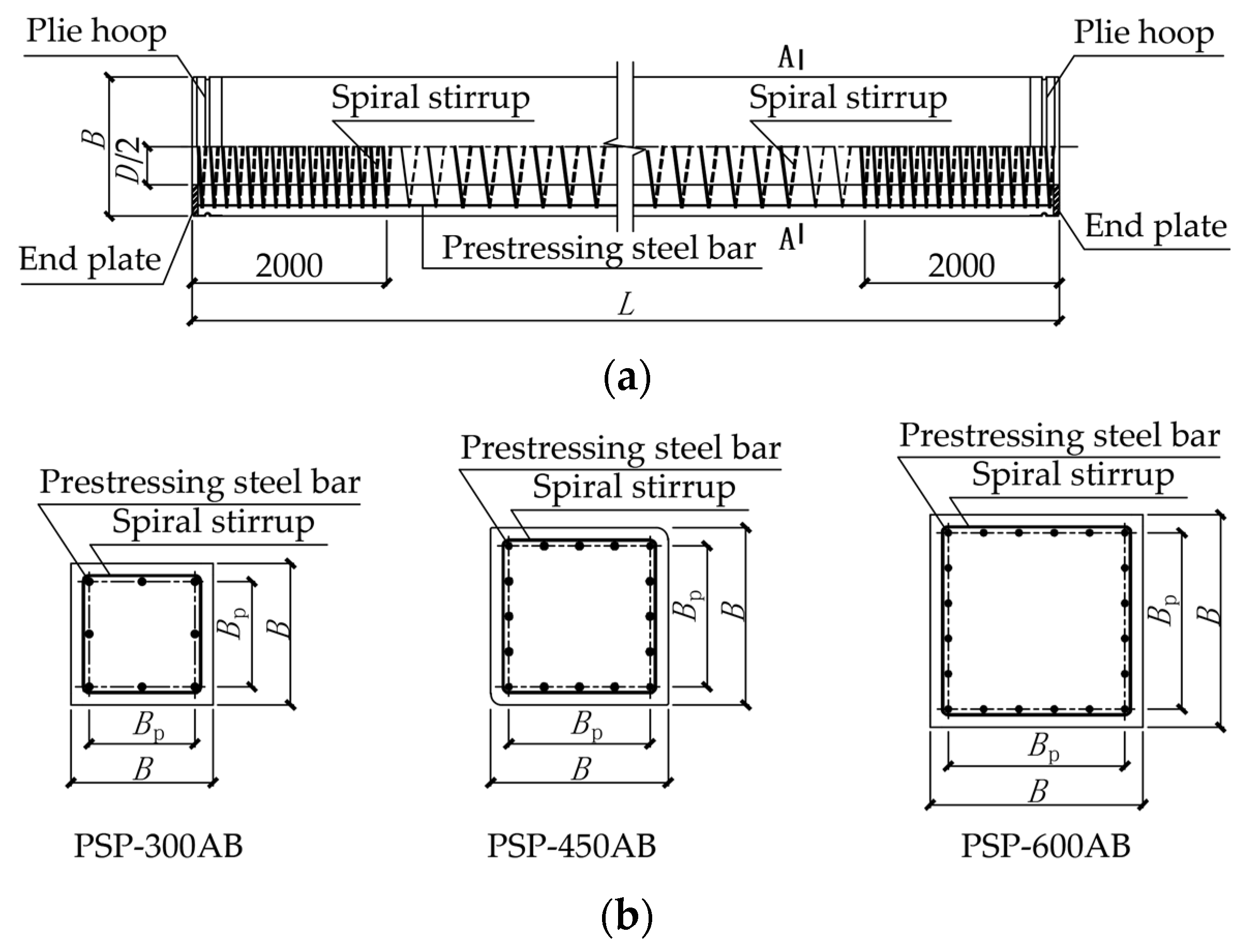
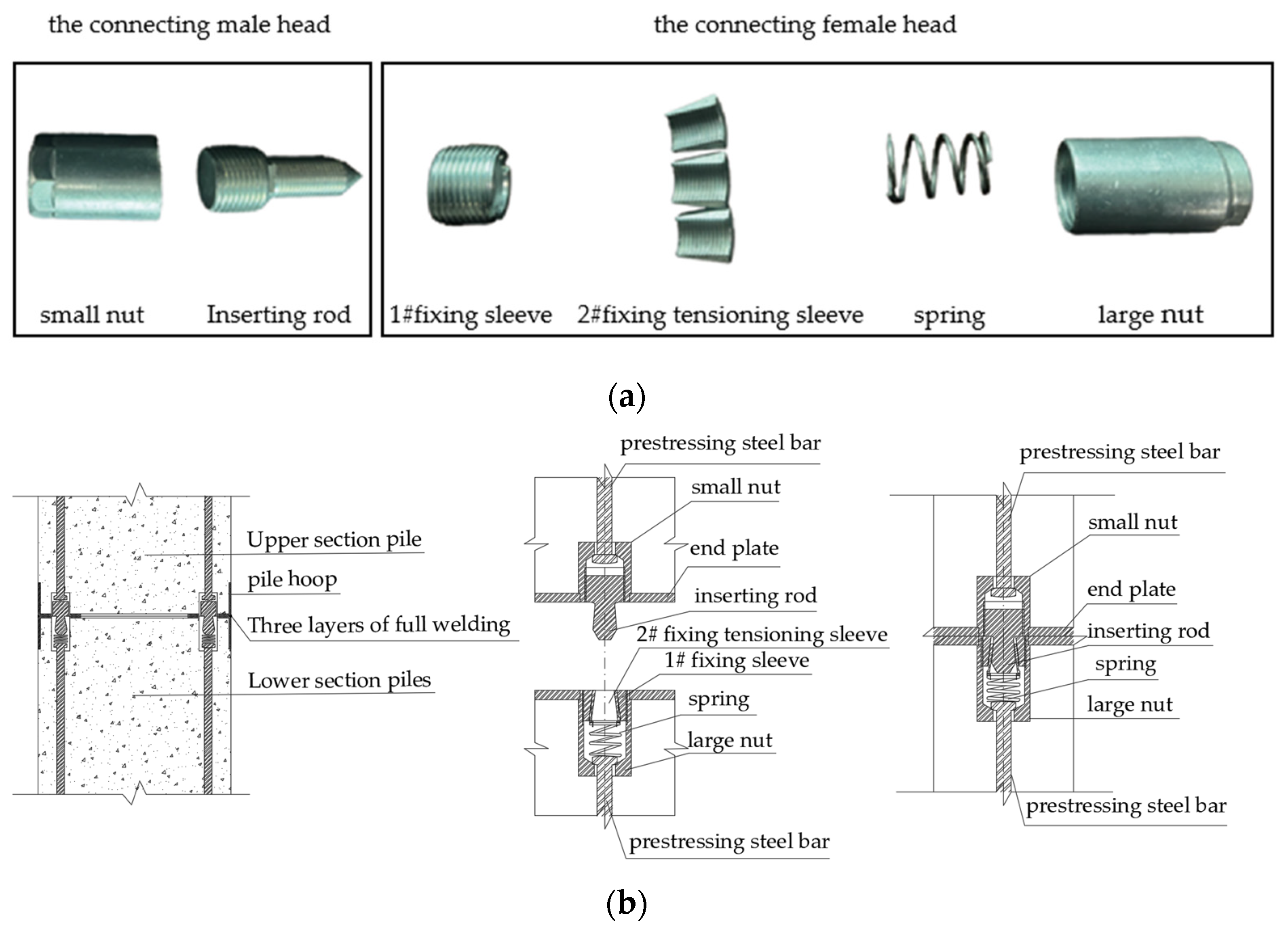


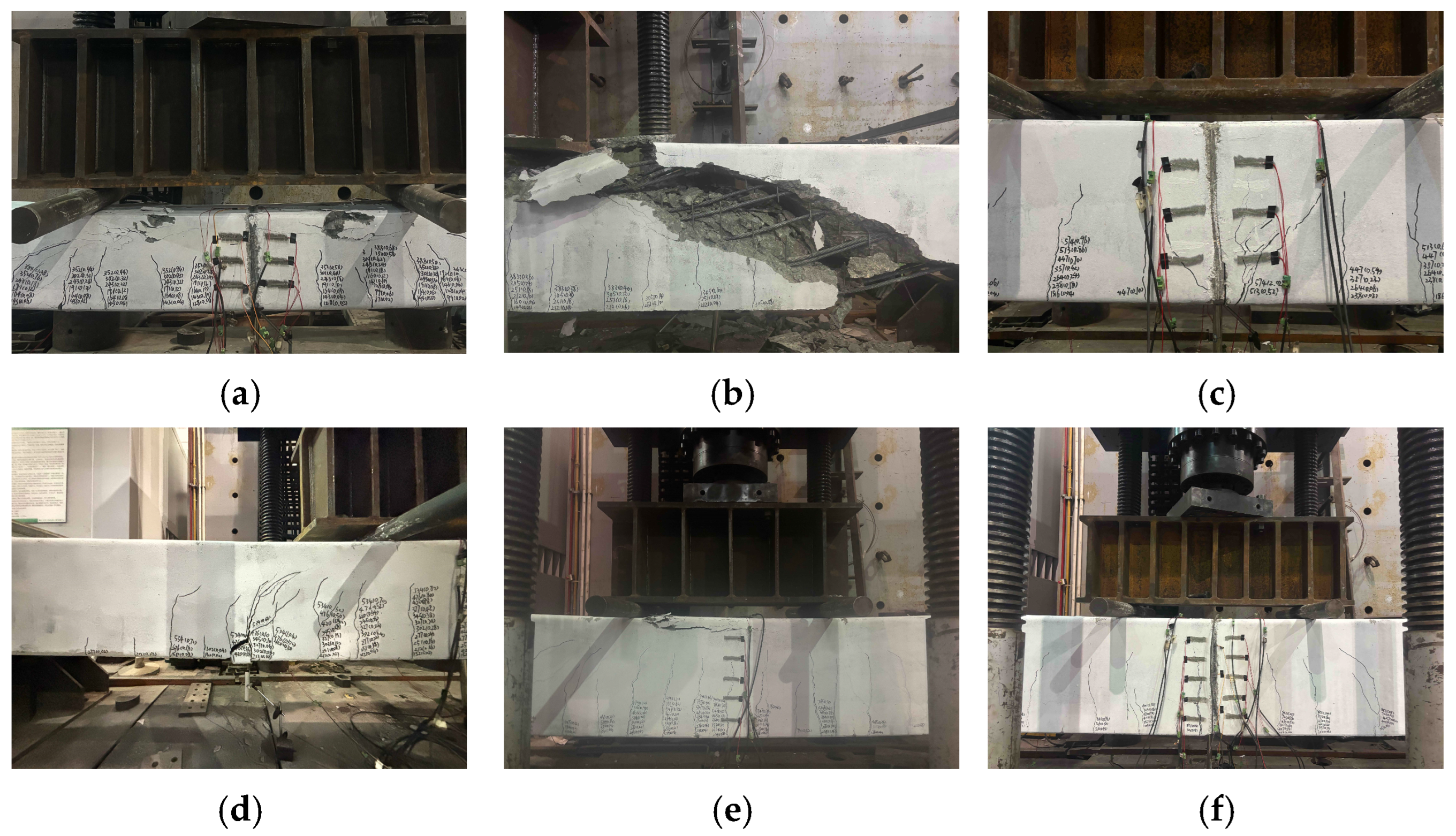
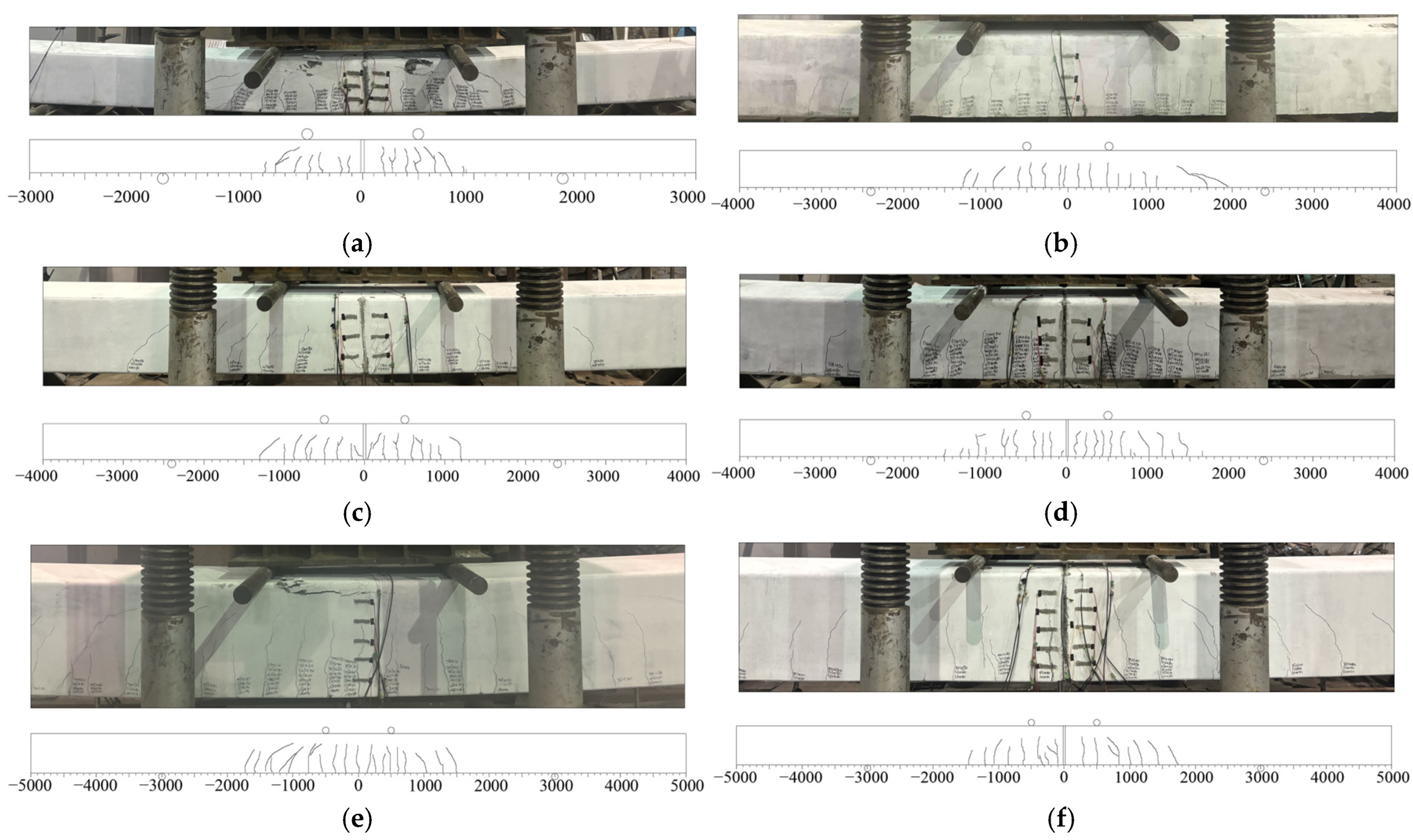
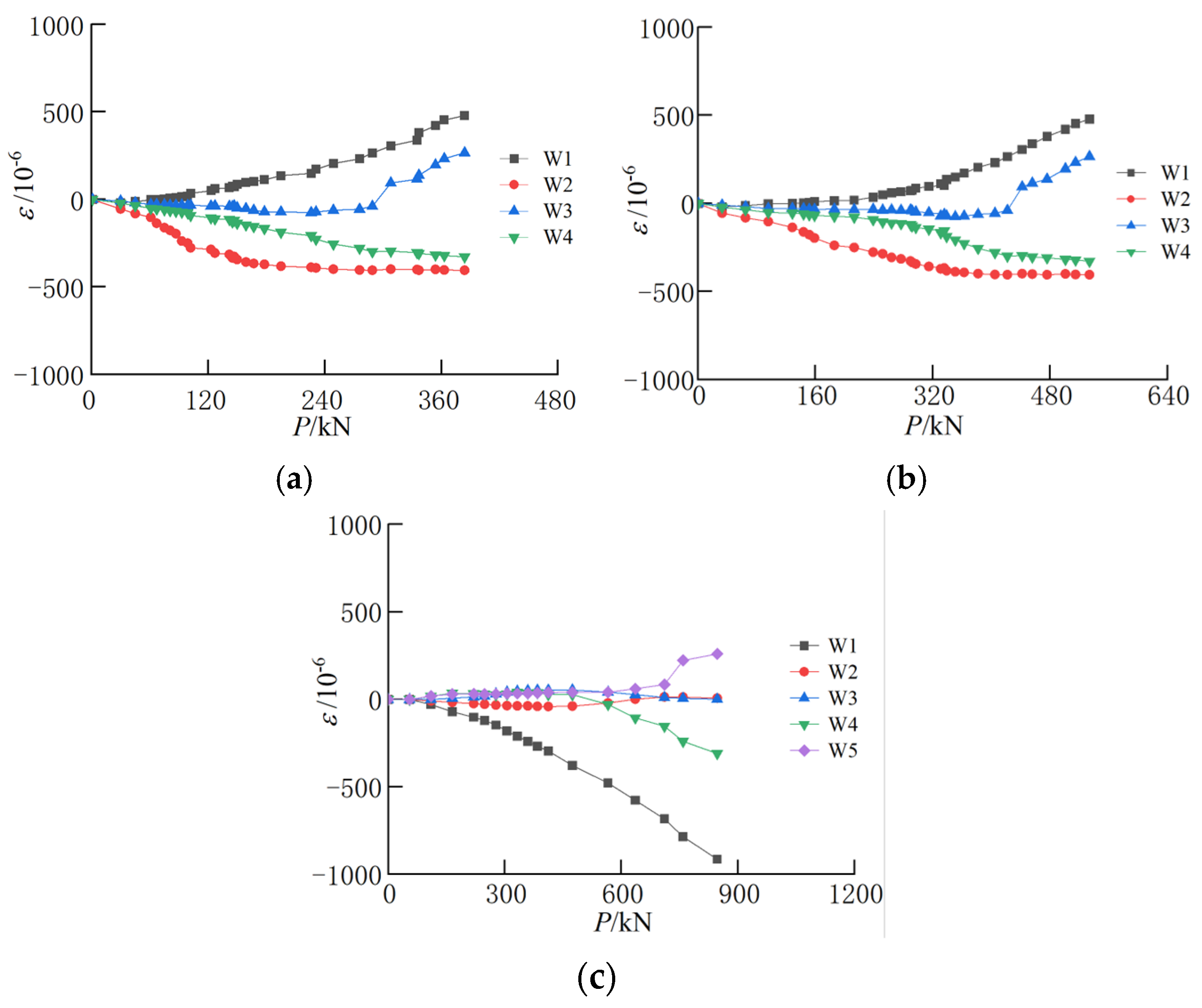
| Specimen | B/mm | BP/mm | Longitudinal Reinforcement | Stirrup | Anchorage Reinforcement |
|---|---|---|---|---|---|
| LKHJ-PSP-300AB | 300 | 208 | 8ΦD10.7 | Φb4@50/100 | 8C14 |
| ZS-PSP-450AB | 450 | 357 | 16ΦD10.7 | Φb5@50/100 | \ |
| LK-PSP-450AB | 450 | 357 | 16ΦD10.7 | Φb5@50/100 | 8C16 |
| LKHJ-PSP-450AB | 450 | 357 | 16ΦD10.7 | Φb5@50/100 | 8C16 |
| ZS-PSP-600AB | 600 | 506 | 20ΦD12.6 | Φb6@50/100 | \ |
| LKHJ-PSP-600AB | 600 | 506 | 20ΦD12.6 | Φb6@50/100 | 12C18 |
| Material Specification | fck/MPa | fpu/MPa | fsu/MPa | Ep/GPa |
|---|---|---|---|---|
| C65 concrete | 91.9 | \ | \ | \ |
| ΦD10.7 prestressed steel bar | \ | 1508.1 | \ | 201.3 |
| ΦD12.6 prestressed steel bar | \ | 1457.8 | \ | 201.7 |
| Φb4 stirrups | \ | \ | 553.0 | 203.8 |
| Φb5 stirrups | \ | \ | 550.6 | 202.6 |
| Φb6 stirrups | \ | \ | 574.9 | 202.6 |
| Specimen | /kN·m | /kN·m | /kN·m | /kN·m | /mm |
|---|---|---|---|---|---|
| LKHJ-PSP-300AB | 56.6 | 49.3 | 254.8 | 106.3 | 55.8 |
| ZS-PSP-450AB | 145.9 | 152.0 | 611.8 | 506.9 | 58.6 |
| LK-PSP-450AB | 144.4 | 152.0 | 532.0 | 506.9 | 43.3 |
| LKHJ-PSP-450AB | 176.7 | 152.0 | 545.3 | 506.9 | 41.0 |
| ZS-PSP-600AB | 327.8 | 345.1 | 1121.8 | 898.2 | 63.9 |
| LKHJ-PSP-600AB | 381.1 | 345.1 | 1107.1 | 898.2 | 47.8 |
| Specimen | wmax/mm | h/mm | r/mm | n | n1 |
|---|---|---|---|---|---|
| LKHJ-PSP-300AB | 1.02 | 260 | −1000~1000 | 14 | 8 |
| ZS-PSP-450AB | 2.12 | 350 | −1300~2000 | 16 | 7 |
| LK-PSP-450AB | 2.02 | 350 | −1500~1500 | 22 | 8 |
| LKHJ-PSP-450AB | 1.40 | 350 | −1300~1200 | 16 | 7 |
| ZS-PSP-600AB | 1.46 | 500 | −1800~1500 | 18 | 7 |
| LKHJ-PSP-600AB | 1.26 | 520 | −1500~1800 | 15 | 5 |
| Specimen | ε1/10−6 | ε2/10−6 |
|---|---|---|
| LKHJ-PSP-300AB | 477 | 381 |
| LKHJ-PSP-450AB | 460 | 364 |
| LKHJ-PSP-600AB | 914 | 259 |
Disclaimer/Publisher’s Note: The statements, opinions and data contained in all publications are solely those of the individual author(s) and contributor(s) and not of MDPI and/or the editor(s). MDPI and/or the editor(s) disclaim responsibility for any injury to people or property resulting from any ideas, methods, instructions or products referred to in the content. |
© 2025 by the authors. Licensee MDPI, Basel, Switzerland. This article is an open access article distributed under the terms and conditions of the Creative Commons Attribution (CC BY) license (https://creativecommons.org/licenses/by/4.0/).
Share and Cite
Xu, Q.; Zhu, Y.; Chen, G.; Xu, D. Experimental Study on Flexural Performance of Screw Clamping and Welding Joint for Prestressed Concrete Square Piles. Buildings 2025, 15, 480. https://doi.org/10.3390/buildings15030480
Xu Q, Zhu Y, Chen G, Xu D. Experimental Study on Flexural Performance of Screw Clamping and Welding Joint for Prestressed Concrete Square Piles. Buildings. 2025; 15(3):480. https://doi.org/10.3390/buildings15030480
Chicago/Turabian StyleXu, Quanbiao, Yajun Zhu, Gang Chen, and Dan Xu. 2025. "Experimental Study on Flexural Performance of Screw Clamping and Welding Joint for Prestressed Concrete Square Piles" Buildings 15, no. 3: 480. https://doi.org/10.3390/buildings15030480
APA StyleXu, Q., Zhu, Y., Chen, G., & Xu, D. (2025). Experimental Study on Flexural Performance of Screw Clamping and Welding Joint for Prestressed Concrete Square Piles. Buildings, 15(3), 480. https://doi.org/10.3390/buildings15030480





